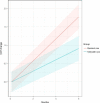Telehealth mitigates COPD disease progression compared to standard of care: a randomized controlled crossover trial
- PMID: 33428219
- PMCID: PMC7986739
- DOI: 10.1111/joim.13230
Telehealth mitigates COPD disease progression compared to standard of care: a randomized controlled crossover trial
Abstract
Background: We showed excellent adherence and satisfaction with our telehealth care (TC) approach for COPD. Here, the results of a consecutive randomized controlled trial are presented.
Methods: Patients were randomly assigned to TC or standard care (SC). During TC, patients answered six daily questions online, and focused on the early recognition of exacerbations, in addition to SC.
Results: The mean increase in COPD assessment test (CAT) was 1.8 vs. 3.6 points/year in the TC and SC groups, respectively (P = 0.0015). Satisfaction with care (VAS) at baseline was 8.2; at the end of SC, 8.5 (P = 0.062); and after TC, 8.8 (P < 0.001). We detected significantly more moderate exacerbations during TC.
Conclusion: Whilst receiving TC, the slope of the CAT increase - an indicator of the naturally progressive course of COPD - was reduced by 50%. Satisfaction with care increased with TC. The higher number of detected moderate exacerbations probably indicates a higher diagnostic sensitivity than without TC.
Keywords: COPD; COPD assessment test; COPD exacerbation; telehealth.
© 2021 The Authors. Journal of Internal Medicine published by John Wiley & Sons Ltd on behalf of Association for Publication of The Journal of Internal Medicine.
Conflict of interest statement
The study was funded by Swisscom Health AG, SWICA Krankenversicherung AG, PneumRx GmbH, AstraZeneca AG and Boehringer Ingelheim Schweiz GmbH. None of these had any influence on design, conduct, interpretation or writing of the manuscript. Prof. Kohler reports personal fees from Bayer, Boehringer, Novartis, Astra and Mundipharma, all outside the submitted work, and grants and personal fees from Roche and GSK. Prof. Tamm reports grants from Vifor AG and Schwabe Pharma AG, all outside the submitted work. Prof. Stolz reports grants from AstraZeneca AG, Curetis AG and Boston Scientific and personal fees from AstraZeneca AG, Novartis AG, GSK AG, Roche AG, Zambon, Pfizer, Schwabe Pharma AG and Vifor AG, all outside the submitted work.
Similar articles
-
A telehealth program for self-management of COPD exacerbations and promotion of an active lifestyle: a pilot randomized controlled trial.Int J Chron Obstruct Pulmon Dis. 2014 Sep 9;9:935-44. doi: 10.2147/COPD.S60179. eCollection 2014. Int J Chron Obstruct Pulmon Dis. 2014. PMID: 25246781 Free PMC article. Clinical Trial.
-
Home-based telehealth hospitalization for exacerbation of chronic obstructive pulmonary disease: findings from "the virtual hospital" trial.Telemed J E Health. 2015 May;21(5):364-73. doi: 10.1089/tmj.2014.0098. Epub 2015 Feb 5. Telemed J E Health. 2015. PMID: 25654366 Free PMC article. Clinical Trial.
-
The evaluation of a remote support program on quality of life and evolution of disease in COPD patients with frequent exacerbations.BMC Pulm Med. 2016 Nov 8;16(1):140. doi: 10.1186/s12890-016-0304-3. BMC Pulm Med. 2016. PMID: 27821164 Free PMC article.
-
Proton pump inhibitors for chronic obstructive pulmonary disease.Cochrane Database Syst Rev. 2020 Aug 25;8(8):CD013113. doi: 10.1002/14651858.CD013113.pub2. Cochrane Database Syst Rev. 2020. PMID: 32844430 Free PMC article.
-
Home telehealth for patients with chronic obstructive pulmonary disease (COPD): an evidence-based analysis.Ont Health Technol Assess Ser. 2012;12(11):1-58. Epub 2012 Mar 1. Ont Health Technol Assess Ser. 2012. PMID: 23074421 Free PMC article. Review.
Cited by
-
Analysis of the effectiveness of remote intervention of patients affected by chronic diseases: A systematic review and meta-analysis.J Med Access. 2023 Sep 28;7:27550834231197316. doi: 10.1177/27550834231197316. eCollection 2023 Jan-Dec. J Med Access. 2023. PMID: 37781504 Free PMC article. Review.
-
Telemedicine and Resource Utilization in Pulmonary Clinic.BMC Pulm Med. 2024 Jun 5;24(1):267. doi: 10.1186/s12890-024-03066-x. BMC Pulm Med. 2024. PMID: 38840112 Free PMC article.
-
Tracking Real-World Physical Activity in Chronic Obstructive Pulmonary Disease Over One Year: Results from a Monocentric, Prospective, Observational Cohort Study.Int J Chron Obstruct Pulmon Dis. 2024 Aug 27;19:1921-1929. doi: 10.2147/COPD.S469984. eCollection 2024. Int J Chron Obstruct Pulmon Dis. 2024. PMID: 39219563 Free PMC article.
-
Content, Mechanism, and Outcome of Effective Telehealth Solutions for Management of Chronic Obstructive Pulmonary Diseases: A Narrative Review.Healthcare (Basel). 2023 Dec 14;11(24):3164. doi: 10.3390/healthcare11243164. Healthcare (Basel). 2023. PMID: 38132054 Free PMC article. Review.
-
Remote Patient Monitoring and Machine Learning in Acute Exacerbations of Chronic Obstructive Pulmonary Disease: Dual Systematic Literature Review and Narrative Synthesis.J Med Internet Res. 2024 Sep 9;26:e52143. doi: 10.2196/52143. J Med Internet Res. 2024. PMID: 39250789 Free PMC article.
References
Publication types
MeSH terms
LinkOut - more resources
Full Text Sources
Other Literature Sources
Medical
Miscellaneous


